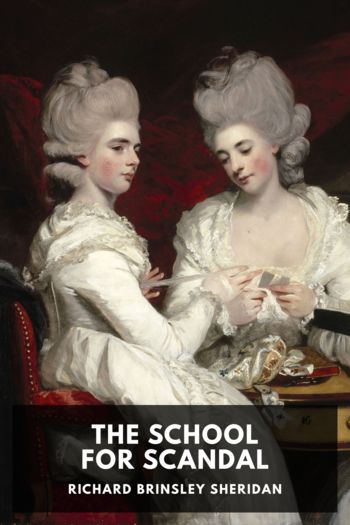The School for Scandal, Richard Brinsley Sheridan [i am reading a book .TXT] 📗

- Author: Richard Brinsley Sheridan
Book online «The School for Scandal, Richard Brinsley Sheridan [i am reading a book .TXT] 📗». Author Richard Brinsley Sheridan
It has been often objected that the hiding of Lady Teazle behind the screen put her in full view of the opposite neighbour, the maiden lady of so curious a temper; but it must be remembered that it is Joseph who makes this remark and has the screen set, and it is Lady Teazle who unwittingly rushes to hide behind it. ↩
The late Abraham Hayward, in his Selected Essays (i. 400), calls this “the recast of a fine reflection in Zadig,” and quotes, in a footnote, Voltaire’s words: “Astarte est femme, elle laisse parler ses regards avec d’autant plus d’imprudence qu’elle ne se croit pas encore coupable. Malheureusement rassuree sur son innocence, elle neglige les dehors necessaires. Je tremblerai pour elle tant qu’elle n’aura rien a se reprocher.” ↩
Boaden, the biographer of Kemble, has the hyper-ingenuity to discover in the fall of the rug in Molly Seagrim’s bedroom, disclosing, the philosopher Square, in Tom Jones, the first germ of the fall of the screen in the School for Scandal. ↩
Nowadays most Sir Peters take this situation to heart as though the School for Scandal were a tragedy, but the play is a comedy, and this scene is, and is meant to be, comic, and not tragic, or even purely pathetic. It is the vanity rather than the honour of Sir Peter in which he feels the wound. If he is as deeply moved as Othello, the following speech of Charles is unspeakably heartless and brutal;—and so, indeed, it is, as it is delivered by most comedians. ↩
The rupee and the pagoda were coins current in Hindustan. The rupee is of silver and is equivalent to about two shillings sterling. The pagoda was either gold or silver, and its value varied from eight to nine shillings sterling. The avadavats mentioned in an earlier speech are birds of brilliant plumage. ↩
“Segoon” is a corruption of segunde, the Spanish form of the French fencing term seconde. Mr. Walter Herries Pollock kindly gave me this information, sought elsewhere in vain. A thrust in segoon, he writes, is “a thrust delivered low, under the adversary’s blade, with the hand in the tierce position, that is, with the knuckles upwards, and the wrist turned downwards. The parry is now more frequently used than is the thrust of seconde, and is especially valuable in disarming; but the thrust is very useful in certain cases, and particularly for one form of the coup d’arret. A lunge in seconde which goes through the lung is nowadays an odd thing to hear of; but such a result might come from the blade of the man using the thrust in seconde being thrown upwards by a slip on the adversary’s blade, arm, or shirt.” ↩
The Montem was a triennial ceremony of the boys at Eton, abolished only in 1847. It consisted of a procession to a mound (ad montem) near the Bath Road, where they exacted money from those present and from all passersby. The sum collected, sometimes nearly £1,000, went to the captain or senior scholar, and served to pay his expenses at the university. There is an interesting account of the Montem in Coningsby. ↩
Tradition formerly authorized Mrs. Candour to interpolate here a query as to whether the postage had been paid or not; but this seems to be carrying the joke a little too far. ↩
In the first draft of the play this speech of Snake’s was in one of the earliest scenes. The anonymous writer of a pamphlet, “Letter to Thomas Moore, Esq., on the subject of Sheridan’s School for Scandal” (Bath, 1826), declares that “this is but boyish composition, and quite too broad even for farce. It might have been said to Snake by another, but is out of even stage-nature or stage-necessity, as coming from himself” (p. 16). ↩
Bayes was the hero of the Duke of Buckingham’s Rehearsal, and was a caricature of John Dryden. At the time this epilogue was written the Rehearsal had not yet been driven from the stage by the Critic. ↩
In the game of ombre, at its height when Pope wrote the “Rape of the Lock,” and still surviving when Colman wrote this epilogue, “Spadille” was the ace of spades, “pam” was the knave of clubs, and “basto” was the ace of clubs. ↩
ColophonThe School for Scandal
was published in 1777 by
Richard Brinsley Sheridan.
This ebook was transcribed and produced for
Standard Ebooks
by
B. Timothy Keith,
and is based on digital scans available at the
Internet Archive.
The cover page is adapted from
The Ladies Waldegrave,
a painting completed in 1780 by
Sir Joshua Reynolds.
The cover and title pages feature the
League Spartan and Sorts Mill Goudy
typefaces created in 2014 and 2009 by
The League of Moveable Type.
The first edition of this ebook was released on
February 10, 2021, 9:54 p.m.
You can check for updates to this ebook, view its revision history, or download it for different ereading systems at
standardebooks.org/ebooks/richard-brinsley-sheridan/the-school-for-scandal.
The volunteer-driven Standard Ebooks project relies on readers like you to submit typos, corrections, and other improvements. Anyone can contribute at standardebooks.org.
UncopyrightMay you do good and not evil.
May you find forgiveness for yourself and forgive others.
May you share freely, never taking more than you give.
Copyright pages exist to tell you can’t do something. Unlike them, this Uncopyright





Comments (0)